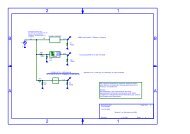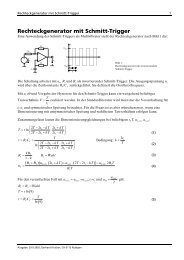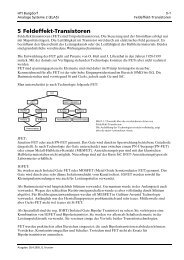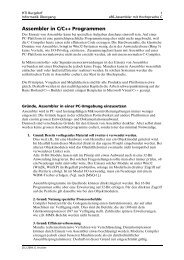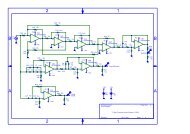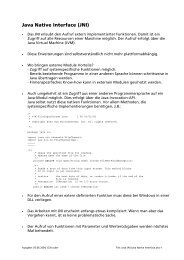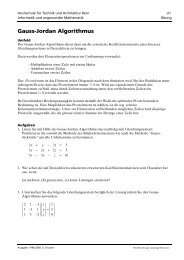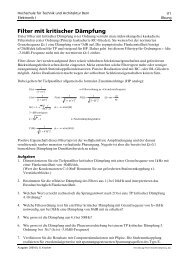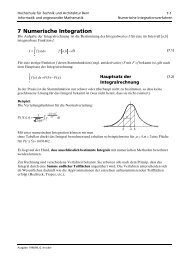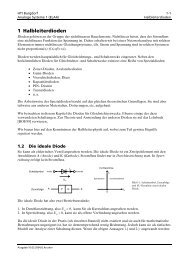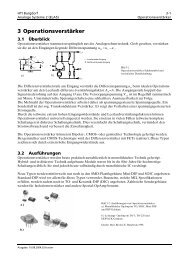Ausgleichs- und Interpolationsrechnung
Ausgleichs- und Interpolationsrechnung
Ausgleichs- und Interpolationsrechnung
Sie wollen auch ein ePaper? Erhöhen Sie die Reichweite Ihrer Titel.
YUMPU macht aus Druck-PDFs automatisch weboptimierte ePaper, die Google liebt.
Hochschule für Technik <strong>und</strong> Architektur BernInformatik <strong>und</strong> angewandte Mathematik3-31<strong>Ausgleichs</strong>- <strong>und</strong> <strong>Interpolationsrechnung</strong>Option Explizit'' Berechnen des Newton-Interpolationswertes fuer die in x, y uebergebenen Datenpunkte' an der Stelle xi' Die Interpolation erfolgt durch das Bestimmen der Newton-Koeffizienten ci <strong>und</strong>' anschliessendes Ausmultiplizieren des Polynoms'' Datum: 21.8.1995, 22.9.1996' Sprache: MS Visual BASIC for Applications EXCEL 7.0'Function NewtonInterpolWert(x, y, xi) As VariantDim AnzX' Anzahl Stuetzstellen in x 'Dim AnzY' Anzahl Stuetzwerte in y 'Dim c' Dynamisches Array für die Koeffizienten ci 'Dim pn' Nennerprodukt (xi-x0)(xi-x1)..(xi-xi-1) 'Dim pz' Zaehlerterm 'Dim Polynomgrad ' Grad des Newton-Interpolationspolynomes 'Dim k' Parameter pruefen 'AnzX = x.CountAnzY = y.CountIf AnzX AnzY Then ' Anzahl x-Wert Anzahl y-Werte: -> Fehler 'NewtonInterpolWert = CVErr(xlErrValue)Exit FunctionEnd IfIf AnzX < 2 Then ' Fuer eine Interpolation braucht es mindestens 2 Datenpunkte sonst: Fehler 'NewtonInterpolWert = CVErr(xlErrValue)Exit FunctionEnd IfPolynomgrad = AnzX - 1' Interpolation durchfueren 'ReDim c(0 To AnzX) ' 0 .. AnzX Polynomkoeffizienten 'c = NewtonC(x, y)' ci's bestimmen 'pz = c(0): pn = 1' Initialisierung 'For k = 1 To Polynomgradpn = pn * (xi - x(k)) ' pn = pn(xi -x[k1]) (EXCEL beginnt mit ersten Element bei 1) 'pz = pz + c(k) * pnNext kNewtonInterpolWert = pzEnd Function'' Bestimmen der Newton-Koeffizienten ci fuer das NewtonInterpolationspolynom' Das Resultat wir als Array mit allen Koeffizeinen c0,..,cn retounrniert.' (EXCEL Array-Funktion)'' Referenz: Haemmerlin, Numerische Mathematik, Seite 111, Verlag Teubner' Datum: 21.8.1995, 22.9.1996' Sprache: MS Visual BASIC for Applications EXCEL 7.0'Function NewtonC(x, y) As VariantDim AnzX' Anzahl Stuetzsellen in x 'Dim AnzY' Anzahl Stuetzwerte in y 'Dim c' Dynamisches Array für die Koeffizienten ci 'Dim pn' Nennerprodukt (xi-x0)(xi-x1)..(xi-xi-1) 'Dim pz' Zaehlerterm 'Dim k, i' Parameter pruefen 'AnzX = x.CountAnzY = y.CountIf AnzX AnzY Then ' Anzahl x-Wert Anzahl y-Werte: -> Fehler 'NewtonC = CVErr(xlErrValue)Exit FunctionEnd IfIf AnzX < 2 Then ' Fuer ein Interpolation braucht es mindestens 2 Datenpunkte sonst: Fehler 'NewtonC = CVErr(xlErrValue)Exit FunctionEnd If' Koeffizienten bestimmen 'ReDim c(0 To AnzX) ' 0 .. AnzX Polynomkoeffizienten 'c(0) = y(1)' c0 = y0 (in EXCEL ist y0 als y(1) indiziert 'For k = 1 To AnzX - 1pn = 1: pz = c(0) ' Initialisierung'For i = 1 To k - 1 ' Sukzessiv ck's aufbauen 'pn = pn * (x(k + 1) - x(i - 1 + 1))pz = pz + c(i) * pnNext ipn = pn * (x(k + 1) - x(k - 1 + 1))c(k) = (y(k + 1) - pz) / pnNext kNewtonC = cEnd FunctionAusgabe: 1996/98, G. Krucker



